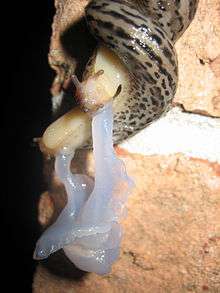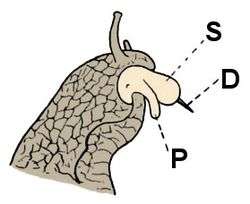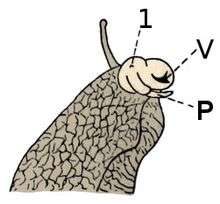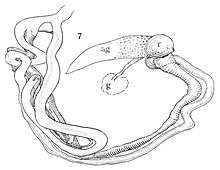Reproductive system of gastropods

The reproductive system of gastropods (slugs and snails) varies greatly from one group to another within this very large and diverse taxonomic class of animals. Their reproductive strategies also vary greatly, see Mating of gastropods.
In many marine gastropods there are separate sexes (male and female); most terrestrial gastropods however are hermaphrodites.
Courtship is a part of the behaviour of mating gastropods. In some families of pulmonate land snails, one unusual feature of the reproductive system and reproductive behavior is the creation and utilization of love darts, the throwing of which have been identified as a form of sexual selection.[1]
Reproduction in marine gastropods
Separate sexes
In many taxonomic groups of marine gastropods, there are separate sexes (i.e. they are dioecious).
In some of the main gastropod clades the great majority of species have separate sexes. This is true in most of the Patellogastropoda, Vetigastropoda, Cocculiniformia, Neritimorpha, and Caenogastropoda.

Protandrous sequential hermaphrodites
Within the clade Littorinimorpha however, the superfamily Calyptraeoidea are protandrous sequential hermaphrodites. Protandry means that the individuals first become male, and then later on become female. See for example the genus Crepidula.
Simultaneous hermaphrodites


Within the main clade Heterobranchia, the informal group Opisthobranchia are simultaneous hermaphrodites (they have both sets of reproductive organs within one individual at the same time).
There are also a few marine pulmonates, and these are also hermaphroditic, for example, see the air-breathing sea slug family Onchidiidae, and the family of air-breathing marine "limpets" Siphonariidae.
Reproductive system of land gastropods
Separate sexes
Although most land snails are pulmonates and are hermaphrodites, in contrast, all of the land-dwelling prosobranch snails are dioecious (in other words, they have separate sexes). This includes the snails in the families Pomatiidae, Aciculidae, Cyclophoridae, and others. These land snails have opercula, which helps identify them as "winkles gone ashore", in other words, snails within the clade Littorinimorpha and the informal group Architaenioglossa.
Simultaneous hermaphrodites

AG = albumen gland
BC = bursa copulatrix
BT = bursa tract
BTD = bursa tract diverticulum
D = love dart
EP = epiphallus
FL = flagellum
FP = fertilization pouch
G = genital pore
HD = hermaphroditic duct
MG = mucus glands (nidamental gland)
OT = ovotestis
P = penis
PRM = penis retractor muscle
S = stylophore or dart sac (bursa telae)
SO = spermoviduct
SP = spermathecae
SRO = spermatophore-receiving organ (indicated in grey)
V = vagina
VD = vas deferens


Pulmonate land gastropods are simultaneous hermaphroditic and their reproductive system is complex. It is all completely internal, except for the active protrusion (eversion) of the penis for copulation. The outer opening of the reproductive system is called the "genital pore"; it is positioned on the right hand side, very close to the head of the animal. This opening is virtually invisible however, unless it is actively in use.
The love-dart (if available) is produced and stored in the stylophore (often called dart sac) and shot by a forceful eversion of this organ. The mucus glands produce the mucus that is deposited on the dart before shooting. The penis is intromitted to transfer the spermatophore. The sperm container is formed in the epiphallus, while the spermatophore's tail is formed by the flagellum. When a bursa tract diverticulum is present, the spermatophore is received in this organ. Together with the bursa tract and bursa copulatrix these form the spermatophore-receiving organ, which digest sperm and spermatophores. Sperm swim out via the tail of the spermatophore to enter the female tract and reach the sperm storage organ (spermathecae) within the fertilization pouch-spermathecal complex.[2]
Variability (polymorphism) of reproductive system in stylommatophorans is common feature.[3] Such variability may include:[3]
- euphallics = male copulatory organs have developed as usual
- hemiphallics = male copulatory organs are reduced
- aphallics = no male copulatory organs develop
also
- in Heterostoma paupercula the epiphallus and flagellum can be either present or absent
- in Arion hortensis there is usually a bipartite oviduct, but there is sometimes a tripartite free oviduct
- in Fruticicola fruticum there is a variable number of mucous gland lobes in the auxiliary copulatory organs
Examples of reproductive system of various land snails:
Genital structures
Genital structures in Stylommatophora include (English name and Latin/Greek name is after the hyphen):
- albumen gland - glandula albuginea[4]
- atrium - atrium / vestibulum[4]
- bursa copulatrix - bursa copulatrix[4]
- dart sac - bursa teloris[4]
- diverticulum - diverticulum[4]
- epiphallar caecum - epiphallus caecum[4]
- epiphallus - epiphallus[4]
- fertilisation pouch - camera fertilis[4]
- flagellum - flagellum[4]
- genital aperture - apertura genitalis[4]
- hermaphroditic duct - ductus hermaphroditicus[4]
- hermaphroditic gland - glandula hermaphroditica, ovotestis[4]
- love dart - spiculum amoris[4]
- mucous glands, digitiform glands - glandulae mucosae[4]
- pedunculus - pedunculus[4]
- penial appendix - appendix[4]
- penial caecum - caecum[4]
- penial papilla - penis papilla[4]
- penial sheath - penis capsula[4]
- penis - penis / phallus[4]
- retractor muscle of the appendix - musculus retractor appendicis[4]
- retractor muscle of the penis - musculus retractor penis[4]
- retractor muscle of the vagina - musculus retractor vaginae[4]
- spermatophore - spermatophora[4]
- spermoviduct - spermoviductus[4]
- prostate - pars prostetica[4] = a gland related to male part of the reproductive system
- uterus - pars uterica[4]
- stimulatory organ - appendicula[4]
- vagina - vagina[4]
- vas deferens - vas deferens / ductus deferens[4]
See also
References
This article incorporates CC-BY-2.0 text (but not under GFDL) from the reference[2]
- ↑ Tales of two snails: sexual selection and sexual conflict in Lymnaea stagnalis and Helix aspersa Oxford Journals
- 1 2 Joris M. Koene & Hinrich Schulenburg. 2005. Shooting darts: co-evolution and counter-adaptation in hermaphroditic snails. BMC Evolutionary Biology, 2005, 5:25 doi:10.1186/1471-2148-5-25.
- 1 2 Backeljau T. et al. Population and Conservation genetics. in Barker G. M. (ed.): The biology of terrestrial molluscs. CABI Publishing, Oxon, UK, 2001, ISBN 0-85199-318-4. 1-146, pages 389-390.
- 1 2 3 4 5 6 7 8 9 10 11 12 13 14 15 16 17 18 19 20 21 22 23 24 25 26 27 28 29 30 (Hungarian) Páll-Gergely B. (2008). "A Stylommatophora csigák ivarszervrendszerének magyar nyelvű nevezéktana". Malacological Newsletter 26: 37-42. PDF.
External links
| Wikimedia Commons has media related to Reproductive system of Gastropoda. |

